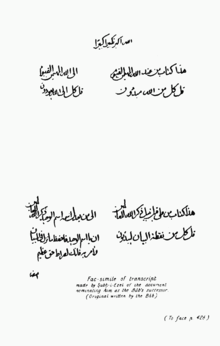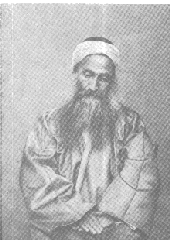Subh-e Azal
Subh-e Azal ( Persian صبح ﺍﺯل, DMG Ṣobḥ-e Azal , 'Morning of Eternity', * 1831 in Tehran , Iran ; † April 29, 1912 in Famagusta , Cyprus ) is the most famous religious honorific title of Mirza Yahya Nuri (میرزا یحیی نوری, DMG Mirzā Yaḥya Nurī , 'Prince Yahya from Nur'), a leader of Babism and founder of Azalism.
Life
Subh-i-Azal was born the son of Mirza Buzurg, a minister from Nur (Persia), and his concubine Kuchik Khanum in the province of Māzandarān . Subh-i-Azal was the younger half-brother of Mirza Husayn Ali Nuri (1817-1892), called Baha'u'llah , the founder of the Baha'i religion . Subh-i-Azal joined in 1846, two years after his half-brother, the Babism religious movement founded by Bab , in which they were to occupy a prominent position. It has not yet been established where the title Subh-i-Azal originates or appears for the first time. Mirza Yahya was apparently not bestowed this honorary title by the Bab. On the other hand, the Bab has related the name Subh-i-Azal to various leading Babi.
Subh-i-Azal as the leader of the Babi
The Bab was arrested as early as 1846 and executed in the course of the Babistic uprisings against state power in 1850. Shortly before his death, the Bab appointed Subh-i-Azal to be the head of the Babi community. Subh-i-Azal had many wives and a large offspring throughout his life. Sources speak of 11, 12 or 17 wives. Subh-i-Azal fled Persia in 1853, leaving his first two wives there. In Baghdad , which was then part of the Ottoman Empire , he joined Baha'u'llah, who was banished from Persia by Shah Naser ad-Din . Although Baha'u'llah asked Subh-i-Azal to return to Persia, he remained in the company of his half-brother. The leadership of the Subh-i-Azal was marked by the assassination attempts he instigated on leading Babi of his time. Subh-i-Azal wrote several books , according to the British orientalist Edward Granville Browne . The diatribe Mustayqiz ('Awakened from sleep') culminated in a downright public appeal for murder against a Babi who was given the name Sayyan ('Judge') by the Bab . The Babi community gradually turned to Baha'u'llah. Baha'u'llah was exiled to Istanbul in 1863 and then to Edirne . Subh-i-Azal also followed him to these stations, leaving at least two of his wives behind. In Istanbul and Edirne, Baha'u'llah made the public claim to an independent revelation from God and claimed to be the fulfillment of the mission of the Bab. In response, Subh-i-Azal also wrote a statement claiming a revelation from God. His community and followers were called "Azali". They tried to portray the Baha'i as politically subversive to the Ottoman government and to eliminate Baha'u'llah. Ongoing conflicts between the Azali and the Baha'i finally led in 1868 to the Ottoman government sending the brothers separately into further exile, Baha'u'llah to Akkon in Palestine and Subh-i-Azal to Famagusta in Cyprus .
Only two of his wives and seven of his children accompanied him to Cyprus. There he lived until 1881 as an exile of the Sultan and then as a pensioner of the British government. As a result of the Russo-Ottoman War , the administration of Cyprus, which until then had been part of the Ottoman Empire, was transferred to Great Britain with the formal recognition of Turkish sovereignty in 1878 . The British orientalist Browne visited Subh-i-Azal in late March to early April 1890 and in March 1896 in Cyprus. In his writings, Browne used the term "Subh-i-Azal" instead of Mirza Yahya, which is probably the reason why he made it public. Subh-i-Azal died in his exile on April 29, 1912 and was buried according to the Islamic , not the Babi rite, as there was no Babi present who could have carried out a Babi funeral. Until the end of his life he tried to preserve the tradition of Babism.
Babism according to Subh-i-Azal
Subh-i-Azal had initially planned his son Ahmad Bahhaj, the eldest son from his association with Fatima, his fourth wife, as his successor. However, there was a falling out between father and son with a civil dispute. The second successor planned by Subh-i-Azal was the Azali leader Mirza Hadi Dawlatabadi from Isfahan , who lived in Persia . Due to the persecution that flared up again in the 1880s, he renounced the Babi belief and held vicious diatribes against the Bab and Baha'u'llah from the pulpit of a mosque . Nevertheless, he remained the Azali leader in Persia. He died a few years before Subh-i-Azal, who then appointed his son Mirza Yahya Dawlatabadi as his successor. He lived in Tehran, became a member of parliament and a public figure; evidently he hardly cared about Babism. Today there seems to be no more central azali community and no head of the azali. Subh-i-Azal's eldest son later accepted the teachings of Baha'u'llah. Babism was thus absorbed in the new teaching of Baha'u'llah, the Baha'i religion. Except for those who became Christians, the Cypriot Azalis were absorbed by the Cypriot Turks . The number of current azalis is estimated at a few thousand, most of which are said to live in Iran.
Individual evidence
- ↑ Atiyya Ruhi: A Brief Biography of His Holiness Subh-i Azal. Retrieved October 22, 2009 .
- ↑ a b c Denis MacEoin: Subh-i-Azal . In: The Encyclopaedia of Islam. New Edition .
- ↑ Sepehr Manuchehri: The Primal Point's Will and Testament . In: Research Notes in Shaykhi, Babi and Baha'i Studies . 2004 ( online ). Online ( Memento of the original dated December 8, 2004 in the Internet Archive ) Info: The archive link was inserted automatically and has not yet been checked. Please check the original and archive link according to the instructions and then remove this notice.
- ^ Edward Granville Browne: Personal Reminiscences of the Babi Insurrection at Zanjan in 1850, written by Aqa `Abdu'l-Ahad-i-Zanjan . In: Journal of the Royal Asiatic Society . 1897, p. 761-827 ( online ).
- ^ Edward Granville Browne: Materials for the Study of the Bábí Religion . Cambridge University Press, Cambridge, UK 1918, pp. 310-312 ( online ).
- ^ DM MacEoin, Art: "Azali Babism" , Encyclopædia Iranica .
- ↑ Shoghi Effendi: God Passes By . Bahá'í Publishing Trust, Wilmette, Illinois, USA 1944, ISBN 0-87743-020-9 , pp. 233 ( online ).
- ^ Moojan Momen: The Cyprus Exiles . In: Bahá'í Studies Bulletin . 1991, p. 99 ( online ).
- ^ Costas M. Constaninou, Epilogue, in: Nicholas Coureas, Marina Elia u. Andrekos Varnava (ed.): The Minorities of Cyprus. Development Patterns and the Identity of the Internal Exclusion, Newcastle upon Tyne 2009, p. 362.
- ↑ Azali . In: Encyclopædia Britannica (ed.): Britannica Concise Encyclopedia . 2006 ( [1] ).
- ↑ David Barrett: The New Believers . Cassell & Co, London, UK 2001, ISBN 0-304-35592-5 , pp. 246 .
literature
- Abdu'l Baha : A Traveller's Narrative: Written to illustrate the episode of the Bab . Ed .: EG Browne. Cambridge University Press, Cambridge, UK 1891 ( online ).
- Abdu'l Baha: A Traveller's Narrative: Written to illustrate the episode of the Bab . Ed .: EG Browne. Kalimát Press, Los Angeles, USA 1886, ISBN 1-890688-37-1 ( online ).
- Shoghi Effendi : God is passing . Bahai-Verlag, Hofheim-Langenhain 1974, ISBN 3-87037-021-1 ( online ).
- Udo Schaefer , Nicola Towfigh, Ulrich Gollmer : Disinformation as a method . Georg Olms Verlag, Hildesheim / Zurich / New York 1995.
- Hasan Balyuzi : Bahá'u'lláh, King of Glory . Ed .: George Ronald. Oxford, UK 2000, ISBN 0-85398-328-3 .
- Hasan Balyuzi: Edward Granville Browne and the Bahá'í-Faith . Ed .: George Ronald. Oxford.
- Abbas Amanat: Resurrection and Renewal: The Making of the Babi Movement in Iran . Cornell University Press, Ithaca 1989.
- Edward Granville Browne: Materials for the Study of the Bábí Religion . Cambridge University Press, Cambridge, UK 1918 ( online ).
- Edward Granville Browne: Personal Reminiscences of the Babi Insurrection at Zanjan in 1850, written by Aqa `Abdu'l-Ahad-i-Zanjan . In: Journal of the Royal Asiatic Society . 1897, p. 761-827 ( online ).
- Juan Cole: Baha'u'llah's Surah of God: Text, Translation, Commentary . In: Translations of Shaykhi, Babi and Baha'i Texts . 2002 ( online ).
- Huseyn Hamadani: The Tarikh-i-Jadid, or New History of Mirza 'Ali Muhammad The Bab . Ed .: EG Browne. Cambridge University Press, Cambridge, UK 1893 ( online ).
- Fabrizio Frigerio,: Un prisonnier d'État à Chypre sous la domination ottomane: Soubh-i-Ezèl à Famagouste . In: Πρακτικά του Γ Διεθνούς Κυπρολογικού Συνέδριου . Nicosia, Cyprus 2001, p. v. 3, 629-646 .
- Jani Kashani: Kitab-i Nuqtat al-Kaf: Being the Earliest History of the Bábís . Ed .: EG Browne. EJ Brill, Leiden, NL 1910 ( online ).
- Sepehr Manuchehri: The Primal Point's Will and Testament . In: Research Notes in Shaykhi, Babi and Baha'i Studies . 2004 ( online ).
- Sepehr Manuchehri: The Practice of Taqiyyah (Dissimulation) in the Babi and Bahai Religions . In: Research Notes in Shaykhi, Babi and Baha'i Studies . 1999 ( online ).
- William M. Miller: The Bahá'í Faith: Its History and Teachings . William Carey Library, 1974, ISBN 0-87808-137-2 .
- Moojan Momen: Mírzá Yahyá . In: Bahá'í Collective Works Project . National Spiritual Assembly of the Bahá'ís of the United States, Evanston, IL 2009 ( Online ).
- Moojan Momen: The Cyprus Exiles . In: Bahá'í Studies Bulletin . 1991, p. 81-113 ( online ).
- Muhammad-`Alíy Salmání: My Memories of Bahá'u'lláh . Kalimát Press, Los Angeles, USA 1982 ( online ).
- Peter Smith: The Bahá'í Religion, A Short Introduction to its History and Teachings . Ed .: George Ronald. Oxford, UK 1988, ISBN 0-85398-277-5 .
- Adib Taherzadeh: The Revelation of Bahá'u'lláh . Ed .: George Ronald. Volume 1: Baghdad 1853-63. Oxford, UK, ISBN 0-85398-270-8 ( online ).
- Adib Taherzadeh: The Covenant of Bahá'u'lláh . Ed .: George Ronald. Oxford, UK 1992, ISBN 0-85398-344-5 .
- Nabíl-i-Zarandí: The Dawn-Breakers: Nabíl's Narrative . Ed .: Shoghi Effendi. Bahá'í Publishing Trust, Wilmette, Illinois, USA 1932, ISBN 0-900125-22-5 ( online ).
Web links
- A Succinct Account of the New Manifestation (English)
- The Primal Point's Will and Testament - Commentary on the Báb's wants (English)
- The Religion of Bayan (English)
- Cyprus Exiles (English)
| personal data | |
|---|---|
| SURNAME | Subh-e Azal |
| ALTERNATIVE NAMES | Nuri, Mirza Yahya; ﺼﺑﺢ ﺍﺯﻞ (Persian); میرز ایحیی نوری (Persian) |
| BRIEF DESCRIPTION | Persian leader of the Babists and Azali |
| DATE OF BIRTH | 1831 |
| PLACE OF BIRTH | Tehran , Iran |
| DATE OF DEATH | April 29, 1912 |
| Place of death | Famagusta , Cyprus |


